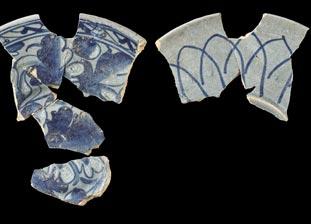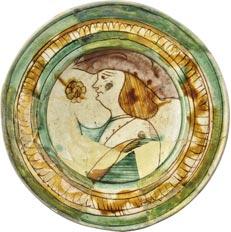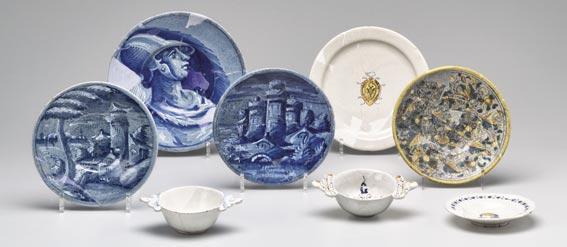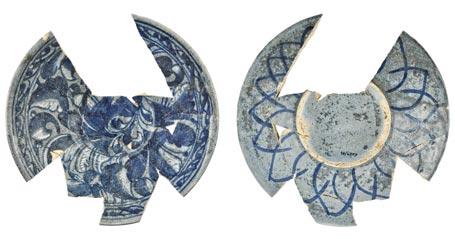
10 minute read
RARE BEAUTY: RENAISSANCE MAIOLICA IN AUSTRIAN ARCHAEOLOGICAL FIND COMPLEXES
from Tin Glaze
Ceramic finds are one of the most important tools for dating archaeological finds. Two fundamental characteristics give ceramics the reputation of being “both a blessing and a curse” for archaeologists: On the one hand, the tendency of potters in all epochs to change the forms of their vessels from time to time (one might add, dictated not only by function but also by fashion), and on the other, the impossibility of recycling clay objects once they have been fired. The wealth of ceramic remains thus permits archaeologists to establish chronology systems that are often the sole means of dating archaeological finds—which is indeed a “blessing.” However, the huge quantity of ceramic material discovered demands a concomitantly massive effort for its scientific processing, constituting the “curse” side of the equation: The sheer mass of material available is one of the greatest obstacles to analyzing archaeological finds.
This is especially true of historical epochs since the late Middle Ages, epochs in which ceramics production occasionally reached early industrial proportions. Amongst the plethora of locally produced ceramic vessels from the Middle Ages and Early Modern era, “alien” objects or those of complex design stand out particularly; such decorated ceramic objects have been sought after by collectors and museums since the nineteenth century and to this day are prominently represented in museums1
However, in archaeological find complexes dating from the Middle Ages and the early modern era, such ceramic objects survive largely only as small fragments, originating as they do mostly from domestic waste, construction rubble, and the like in settlement contexts. It is thus more gratifying when the objects from abroad that are discovered are larger, better-preserved, and more straightforward to date. Such a case prompted a short analysis of archaeological finds of Renaissance Italian tin-glazed earthenware in Austria2
Two Venetian Maiolica Plates From Castle Orth On The Danube
In 2004, an archaeological excavation took place during extensive reconstruction and renovation work at Castle Orth on the Danube in Lower Austria3. Although the excavation was severely limited by the extent of the planned construction work, an interesting find was made in a section on the north east corner of the castle, a sewer constructed of bricks with attached collecting tank, whose backfilling yielded valuable finds4. Besides an almost fully preserved glass goblet, dated to the second third of the sixteenth century, the finds included large fragments of two maiolica plates, whose similarity indicated that they were probably manufactured in the same workshop. They had obviously also been displosed of together.
Based on their greyish-blue glaze and cobalt blue brushwork, both plates could be identified as berettino ware5; their white a foglie decoration in particular speaks for a Venetian origin6 [fig. 1]. The somewhat coarse brushwork on these two items from Orth suggests that they were manufactured in the late sixteenth century, very shortly before 16007, although the size of the missing area makes it difficult to make a precise stylistic judgement. On their display side, one can make out a two-dimensional design consisting of oak-leaf-shaped foliage with some roundish-oval fruits, surrounded by a stylized foliate border around the edge. The reverse has a ring of overlapping pointed arches around the sides8
Both these extraordinary finds fall within that period of Castle Orth’s history corresponding to its ownership by the noble families of Salm and Zinzendorf—undoubtedly the heyday of this fortress located on the Danube to the east of Vienna. Both the Counts of Salm and the Lords of Zinzendorf maintained close personal ties with northern Italy and Venice, from which one can deduce that the plates found their way to Orth thanks to these contacts. Whether the plates (and the glass goblet) were thrown away as the result of a change of ownership around 1600 cannot be determined.
MAIOLICA FROM ARCHAEOLOGICAL FIND COMPLEXES IN AUSTRIAA PRELIMINARY RÉSUMÉ
Research on the plate fragments from Orth has revealed that hitherto scarcely any record exists of find complexes containing northern Italian maiolica of similar age in Austria. In contrast, archaeological parallels certainly are available from the Adriatic9, Slovakia10, Germany11, and the Netherlands12, as well as in museums. This prompted me to conduct a broad-based survey among colleagues researching in this field to determine the existence of such finds within the Republic of Austria. Although the results of this spontaneously organized survey cannot of course be considered representative, they provide initial insights into the topic under discussion—insights that are highly enlightening.
The author is aware of only two verified archaeological finds of Renaissance maiolica in Vienna, a city that was, after all, by that time the residence of the Holy Roman Emperor and thus undoubtedly an important market for imports of high-quality maiolica13. These are fragments of a footed bowl and a plate, attributed to a workshop in Faenza in the second half of the sixteenth century14. Both pieces were discovered in layers of earth levelled for the construction of the new Vienna University (1623 to 1654), a prominent location. Otherwise, it appears that no Italian maiolica has been unearthed by the numerous —in part extensive and high-yield—excavations of past decades in Vienna’s inner city. Even if one considers that in most cases the find complexes still await scientific evaluation, preliminary investigations point to their being an almost total lack of maiolica products on the Viennese market of that time.

A small painted fragment from the Charterhouse of Mauerbach (Lower Austria) has likewise been identified as “probably Italian maiolica,” although its origin cannot be verified from the illustration available15. Otherwise, the author is not aware of any such finds from Lower Austria,16 nor from the Burgenland,17 Styria,18 or (remarkably) the Tyrol19 or Vorarlberg. But the situation is completely different in Carinthia, Upper Austria, and Salzburg.
Finds of Italian tin-glazed earthenware from the early modern period in Carinthia are obviously rare, though they do occur20. For instance, a fragment of a maiolica vessel (a jug or a carafe) was recently recovered during a conservation excavation near a patrician townhouse in Villach and was identified as originating from Faenza or Urbino in the fifteenth century. The find has been interpreted as evidence of the property’s prosperity under the Khevenhüller family in the fifteenth and sixteenth centuries21
Archaeological find complexes in Upper Austria are clearly much richer in northern Italian maiolica22, even though current even though current literature on them on them is quite sparse. What is remarkable is that the finds that have come to the author’s attention all stem from castles: Oberwallsee near Feldkirchen23, Burg Waxenberg near Oberneukirchen 24 , and Windhaag near Perg: This last-mentioned find features a plate with what appears to be a mythological motif, very likely manufactured in Urbino25. One may cautiously surmise that in Upper Austria ownership of maiolica was more widespread amongst the nobility than was the case (based on our present knowledge) in, for instance, Lower Austria.
1 See Glaser 2000, pp. IX–XVIII; Heege und Kistler 2017, p. 32.
2 The author would like to thank Timothy Wilson and Rainald Franz for inviting him to write the present contribution.
3 An evaluation of all currently available sources on the archaeology, archives, and building history of Castle Orth took place as part of a project of a project extending over many years, whose results have been recently published. See Hofer et al. 2021.
4 The sewer and its backfill have been dated to excavation phases 7 and 8 (second half of the sixteenth to end of the sixteenth/early seventeenth century (Hofer et al. 2021).
5 Jaspers 2009, pp. 3–5. Many thanks to Andreas Heege for identifying the plates’ Italian origin and to Nina Linde Jaspers for further valuable information, in particular on Venetian maiolica.
6 Jaspers 2009, pp. 5–6; Jaspers 2011, p. 15.
7 See, for instance Jaspers 2009, p. 7, fig. 8 (dated 1580–1625).
8 Very similar plates in the Germanisches Nationalmuseum in Nuremberg have been dated between 1550 and 1568: Glaser 2000, pp. 234–35, 237.
9 Examples include the Gnalić (Croatia) shipwreck of 1583, see Mileusnić 2006, pp. 106–07, fig. 8 (“Maiolica berettina”); Piran (Slovenia), see Guštin 2006, p. 31, fig. 6/4 (sixteenth to seventeenth century); Central Dalmatia, see ZglavMartinac 2006, p. 137, 139 (sixteenth century); Stari Bar (Montenegro), see Zagarčanin 2004, pp. 105, 115, fig. 125; p. 124, fig. 154.
10 Španihel 2015 (thanks to Nina L. Jaspers for this reference).
11 For instance, from Stralsund: Samariter 2016.
12 Jaspers 2011.
13 Many thanks to Ingeborg Gaisbauer, Karin Kühtreiber, and Thomas Kühtreiber for providing information on this point.
14 Kühtreiber 2006, vol. 1, pp. 219–20; vol. 2, p. 229, fig. 42/A548–A549 (thanks to Thomas Kühtreiber).
15 Kreitner 1998, p. 378 (thanks to Martin Krenn).
16 Many thanks to Martin Krenn, Gabriele Scharrer-Liška, and Ute Scholz for sharing this information.
17 Many thanks to Nikolaus Franz for sharing this information.
18 Many thanks to Johanna Kraschitzer and Manfred Lehner for sharing this information.
19 Many thanks to Johannes Pöll and Harald Stadler for sharing this information.
20 Many thanks to Manfred Lehner und Claus Vetterling for sharing this information.
21 Friedrich und Vetterling 2019 (thanks to Claus Vetterling for sharing this information). From Castle Ras (Gradišče na Turnah near St Jakob im Rosental; thanks to Manfred Lehner for sharing this information) originate fragments of a jar, possibly identifiable as maiolica arcaica from the late Middle Ages. The find is currently being researched by Anna Fercher as part of an MA dissertation.
22 Many thanks to Heinz Gruber, Alice Kaltenberger and Christina Schmid for sharing this information.
But the find complexes with the richest yields of Italian faience are clearly to be found in the city of Salzburg26. Two almost completely preserved plates were recovered on the site of the Toskanatrakt—built between 1607 and 1614—of the archbishop’s residence. The plates were found in the massive cesspits of two patrician houses dating from the late Middle Ages, which in 1605 had had to make way for construction of the new Toskanatrakt. In the cesspit of House no. 1—owned before its demolition by the prominent burgher and innkeeper Philipp Schinagl—Venetian glass and a maiolica plate were unearthed, the latter identified as manufactured in Faenza Faenza, alongside large quantities of other ceramic fragments (including imports from Germany).27 The second plate was found in the cesspit of House no. 4, part of the Wispeckenhof, the property of Heinrich Venediger (“the Venetian”!). This plate, however, has been identified as earlier ceramica graffita and dated in the first half of the sixteenth century28 [fig. 2].
A second qualitatively and quantitively even more spectacular find complex came to light in an excavation at the Salzburg SchatzHaus (Getreidegasse 3 and 3a). In the sixteenth century, this property was owned by the renowned patrician families of Ritzinger and Rauchenperger29. The extremely numerous high-quality finds, made of various materials, were recovered from the backfilling of a cellar that in the sixteenth and seventeenth centuries was additionally used as a cesspit. Besides numerous imported objects from Germany, the find included many maiolica jars, several of which were clearly made in Venice30. Of particular interest are a number of plates (some of them almost undamaged) featuring a foliate decoration very similar to that on the finds from Orth on the Danube, thus very likely originating from the same workshop and establishing a possible link between the two locations [figs. 3, 4]
In summarizing the current state of knowledge gleaned from the Salzburg finds, one may conclude that northern Italian maiolica was used in the city’s patrician households in the sixteenth century, together with Venetian glassware. A comparable concentration of maiolica ware has hitherto not been recorded elsewhere in Austria.
CONCLUSION: BEAUTY IS RARETHOUGH NOT EVERYWHERE
Before summing up this short review, it is necessary once again to emphasize two things. First of all, this synopsis of Renaissance maiolica finds in Austria is by no means representative, merely reflecting information available to the author or communicated to him by colleagues. It is thus possible that other (perhaps many) unknown or unpublished maiolica finds await discovery in various locations. Secondly, it must be emphasized that a truly accurate attribution of the objects described to specific Italian workshops would require art-historical—and above all scientific—analysis that was too intensive to be realized within the scope of this article.
The spectrum of finds presented here nevertheless seems to permit certain conclusions to be drawn, in particular regarding the quantity of finds in the individual federal states of Austria and the specific circumstances surrounding the finds themselves. Judging by the current state of research and literature, it is clear that Salzburg, Upper Austria, and Carinthia are the major areas of maiolica distribution, followed by Vienna and Lower Austria with only a few individual items each, then finally the Tyrol, Vorarlberg, Styria, and Burgenland with none at all. The large number of items found in Salzburg is undoubtedly due to the city’s close trading ties with Venice31, obviously including trade in ceramics. The city’s geographical proximity to Upper Austria possibly contributed to some of these imports finding their way to that area. In the case of Carinthia, on the one hand its proximity to northern Italian production centres, and on the other, the traditional importance of Salzburg in this former duchy must also have played a role.
If one now considers the circumstances surrounding the finds, in Salzburg maiolica was clearly to be found in the households of patrician merchants, possibly because they themselves were involved in the maiolica trade. On the other hand, maiolica finds in other locations are primarily linked to the aristocracy—such maiolica wares were veritable prestige objects whose acquisition was possible only for a certain class of buyer. However, personal connections to Italy, such as were maintained by the Counts of Salm and the Lords of Zinzendorf in Orth on the Danube, perhaps accounted for their acquiring of maiolica from that source. Perhaps while staying in northern Italy they discovered and learned to appreciate the magnificent colours of maiolica tableware.


In any case, Renaissance maiolica from northern Italy is a conspicuous—if for the most part rare—guest in Austria’s archaeological excavations. But precisely this circumstance makes it an extremely interesting research subject, since it is not only datable with relative precision but also affords some remarkable insights into the representation efforts of sixteenth- and early seventeenth-century upper-class society.

24 Thanks are due to Heinz Gruber.
25 Reiter 2012, p. 85 (thanks to Heinz Gruber). Fragment of a plate with yellow edging and probably a mythological scene in the centre. The style is strongly reminiscent of a plate from Urbino in the Germanisches Nationalmuseum in Nuremberg (Glaser 2000, p. 132, fig. 129a).
26 Many thanks to Ulli Hampel (Salzburg Museum) for pointing out the Salzburg finds, and to Holger Wendling (Salzburg Museum) for sharing the photo material.
27 Kovacsovics 1989/90, pp. 18–27, 306.
28 Kovacsovics 1989/90, pp. 30–34, 357–358.
29 Husty and Rinnerthaler 2008, pp. 10–11.
30 Kovacsovics 2008. The rich amount of material from the excavation has only to a small extent been evaluated. See Ruttner 2008. Considering its quality and excellent condition, a complete appraisal of the find is greatly to be desired.
31 See Wilk 2013, p. 89 (with additional literature).




